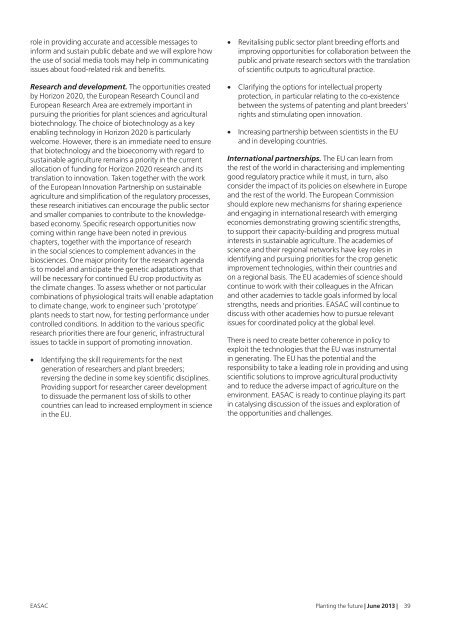Planting the future: opportunities and challenges for using ... - EASAC
Planting the future: opportunities and challenges for using ... - EASAC
Planting the future: opportunities and challenges for using ... - EASAC
You also want an ePaper? Increase the reach of your titles
YUMPU automatically turns print PDFs into web optimized ePapers that Google loves.
ole in providing accurate <strong>and</strong> accessible messages to<br />
in<strong>for</strong>m <strong>and</strong> sustain public debate <strong>and</strong> we will explore how<br />
<strong>the</strong> use of social media tools may help in communicating<br />
issues about food-related risk <strong>and</strong> benefits.<br />
Research <strong>and</strong> development. The <strong>opportunities</strong> created<br />
by Horizon 2020, <strong>the</strong> European Research Council <strong>and</strong><br />
European Research Area are extremely important in<br />
pursuing <strong>the</strong> priorities <strong>for</strong> plant sciences <strong>and</strong> agricultural<br />
biotechnology. The choice of biotechnology as a key<br />
enabling technology in Horizon 2020 is particularly<br />
welcome. However, <strong>the</strong>re is an immediate need to ensure<br />
that biotechnology <strong>and</strong> <strong>the</strong> bioeconomy with regard to<br />
sustainable agriculture remains a priority in <strong>the</strong> current<br />
allocation of funding <strong>for</strong> Horizon 2020 research <strong>and</strong> its<br />
translation to innovation. Taken toge<strong>the</strong>r with <strong>the</strong> work<br />
of <strong>the</strong> European Innovation Partnership on sustainable<br />
agriculture <strong>and</strong> simplification of <strong>the</strong> regulatory processes,<br />
<strong>the</strong>se research initiatives can encourage <strong>the</strong> public sector<br />
<strong>and</strong> smaller companies to contribute to <strong>the</strong> knowledgebased<br />
economy. Specific research <strong>opportunities</strong> now<br />
coming within range have been noted in previous<br />
chapters, toge<strong>the</strong>r with <strong>the</strong> importance of research<br />
in <strong>the</strong> social sciences to complement advances in <strong>the</strong><br />
biosciences. One major priority <strong>for</strong> <strong>the</strong> research agenda<br />
is to model <strong>and</strong> anticipate <strong>the</strong> genetic adaptations that<br />
will be necessary <strong>for</strong> continued EU crop productivity as<br />
<strong>the</strong> climate changes. To assess whe<strong>the</strong>r or not particular<br />
combinations of physiological traits will enable adaptation<br />
to climate change, work to engineer such ‘prototype’<br />
plants needs to start now, <strong>for</strong> testing per<strong>for</strong>mance under<br />
controlled conditions. In addition to <strong>the</strong> various specific<br />
research priorities <strong>the</strong>re are four generic, infrastructural<br />
issues to tackle in support of promoting innovation.<br />
• Identifying <strong>the</strong> skill requirements <strong>for</strong> <strong>the</strong> next<br />
generation of researchers <strong>and</strong> plant breeders;<br />
reversing <strong>the</strong> decline in some key scientific disciplines.<br />
Providing support <strong>for</strong> researcher career development<br />
to dissuade <strong>the</strong> permanent loss of skills to o<strong>the</strong>r<br />
countries can lead to increased employment in science<br />
in <strong>the</strong> EU.<br />
• Revitalising public sector plant breeding ef<strong>for</strong>ts <strong>and</strong><br />
improving <strong>opportunities</strong> <strong>for</strong> collaboration between <strong>the</strong><br />
public <strong>and</strong> private research sectors with <strong>the</strong> translation<br />
of scientific outputs to agricultural practice.<br />
• Clarifying <strong>the</strong> options <strong>for</strong> intellectual property<br />
protection, in particular relating to <strong>the</strong> co-existence<br />
between <strong>the</strong> systems of patenting <strong>and</strong> plant breeders’<br />
rights <strong>and</strong> stimulating open innovation.<br />
• Increasing partnership between scientists in <strong>the</strong> EU<br />
<strong>and</strong> in developing countries.<br />
International partnerships. The EU can learn from<br />
<strong>the</strong> rest of <strong>the</strong> world in characterising <strong>and</strong> implementing<br />
good regulatory practice while it must, in turn, also<br />
consider <strong>the</strong> impact of its policies on elsewhere in Europe<br />
<strong>and</strong> <strong>the</strong> rest of <strong>the</strong> world. The European Commission<br />
should explore new mechanisms <strong>for</strong> sharing experience<br />
<strong>and</strong> engaging in international research with emerging<br />
economies demonstrating growing scientific strengths,<br />
to support <strong>the</strong>ir capacity-building <strong>and</strong> progress mutual<br />
interests in sustainable agriculture. The academies of<br />
science <strong>and</strong> <strong>the</strong>ir regional networks have key roles in<br />
identifying <strong>and</strong> pursuing priorities <strong>for</strong> <strong>the</strong> crop genetic<br />
improvement technologies, within <strong>the</strong>ir countries <strong>and</strong><br />
on a regional basis. The EU academies of science should<br />
continue to work with <strong>the</strong>ir colleagues in <strong>the</strong> African<br />
<strong>and</strong> o<strong>the</strong>r academies to tackle goals in<strong>for</strong>med by local<br />
strengths, needs <strong>and</strong> priorities. <strong>EASAC</strong> will continue to<br />
discuss with o<strong>the</strong>r academies how to pursue relevant<br />
issues <strong>for</strong> coordinated policy at <strong>the</strong> global level.<br />
There is need to create better coherence in policy to<br />
exploit <strong>the</strong> technologies that <strong>the</strong> EU was instrumental<br />
in generating. The EU has <strong>the</strong> potential <strong>and</strong> <strong>the</strong><br />
responsibility to take a leading role in providing <strong>and</strong> <strong>using</strong><br />
scientific solutions to improve agricultural productivity<br />
<strong>and</strong> to reduce <strong>the</strong> adverse impact of agriculture on <strong>the</strong><br />
environment. <strong>EASAC</strong> is ready to continue playing its part<br />
in catalysing discussion of <strong>the</strong> issues <strong>and</strong> exploration of<br />
<strong>the</strong> <strong>opportunities</strong> <strong>and</strong> <strong>challenges</strong>.<br />
<strong>EASAC</strong> <strong>Planting</strong> <strong>the</strong> <strong>future</strong> | June 2013 | 39


